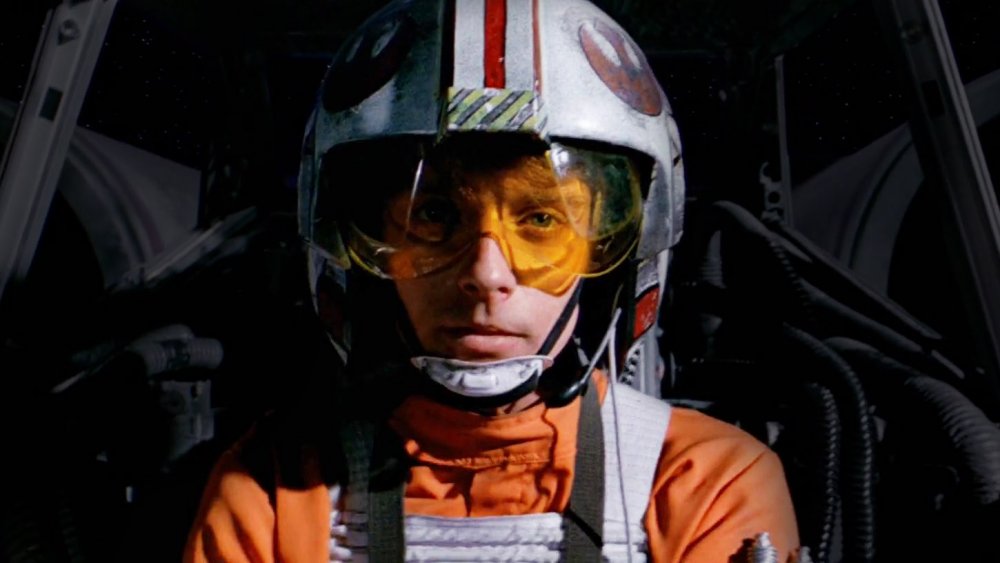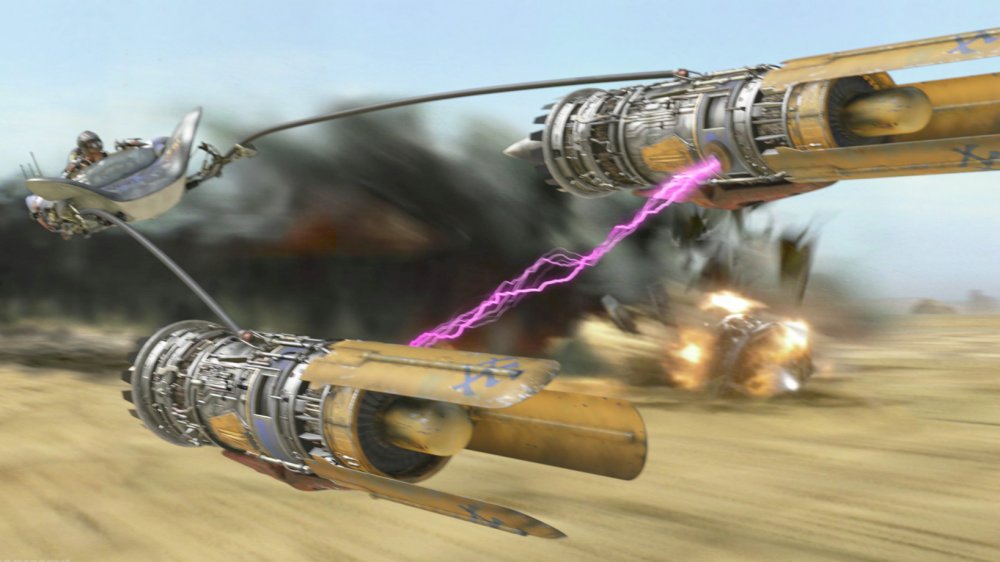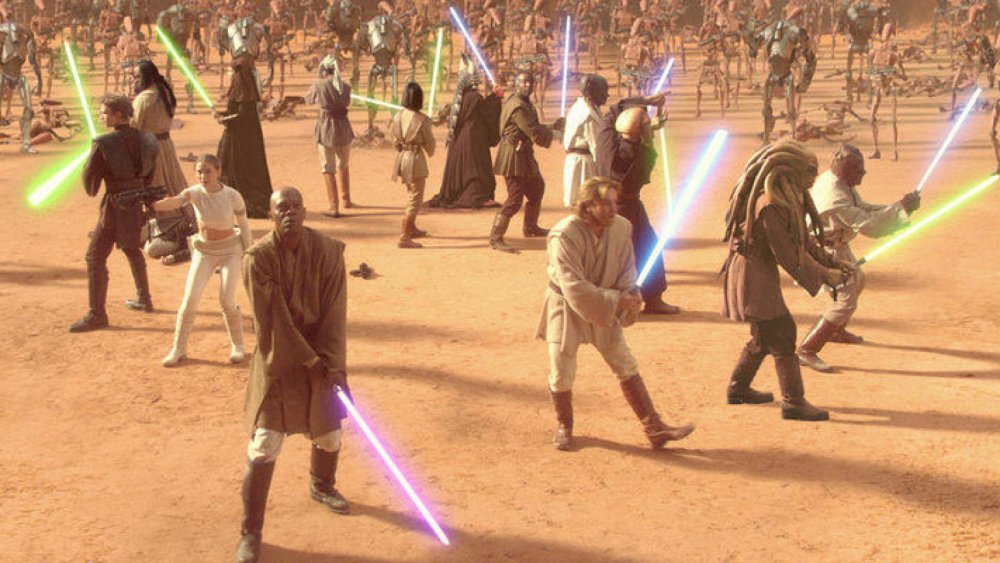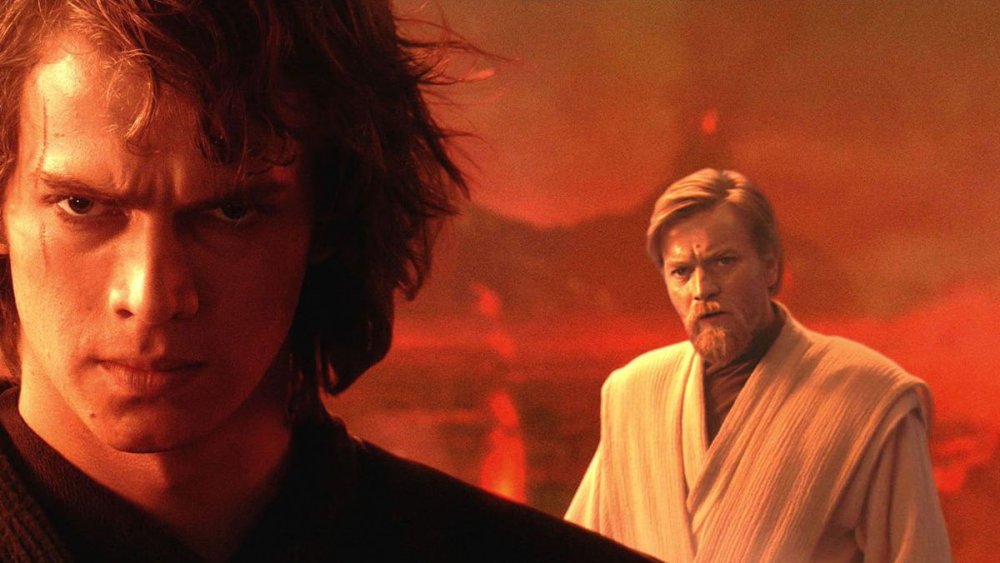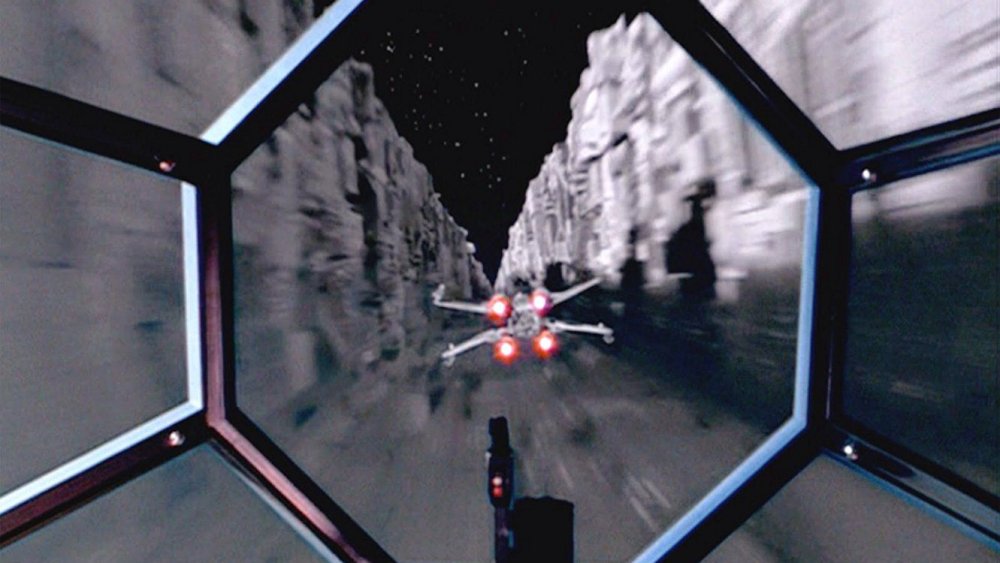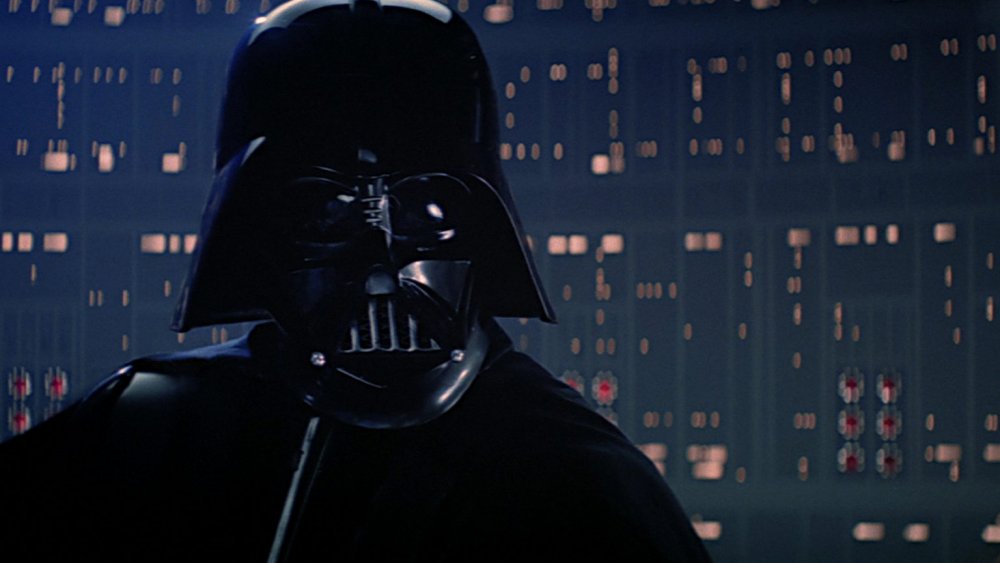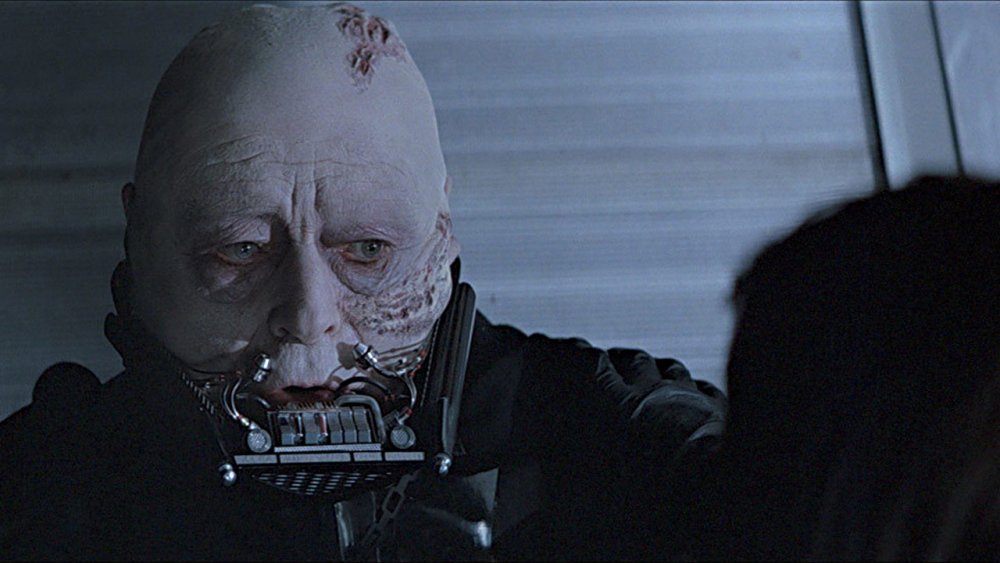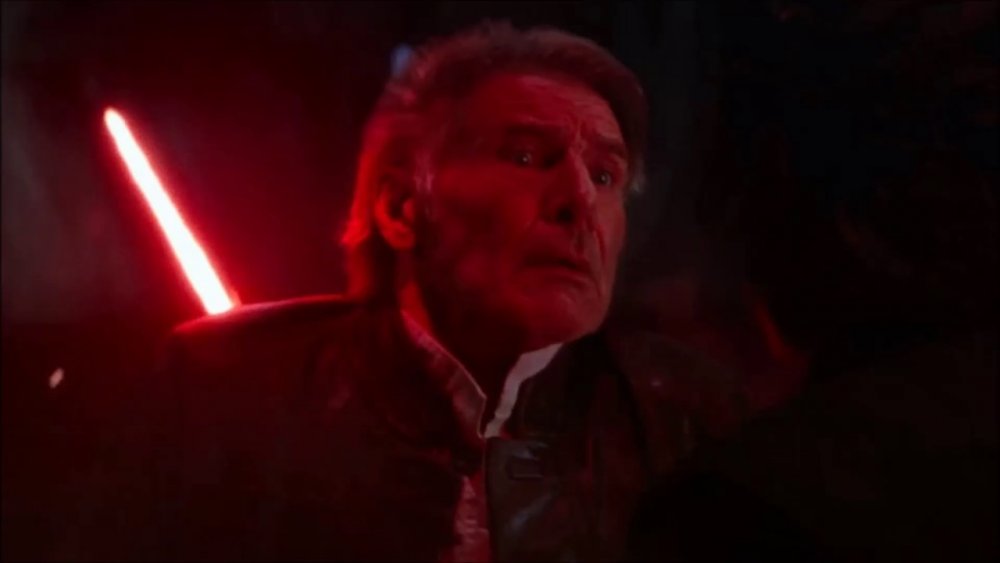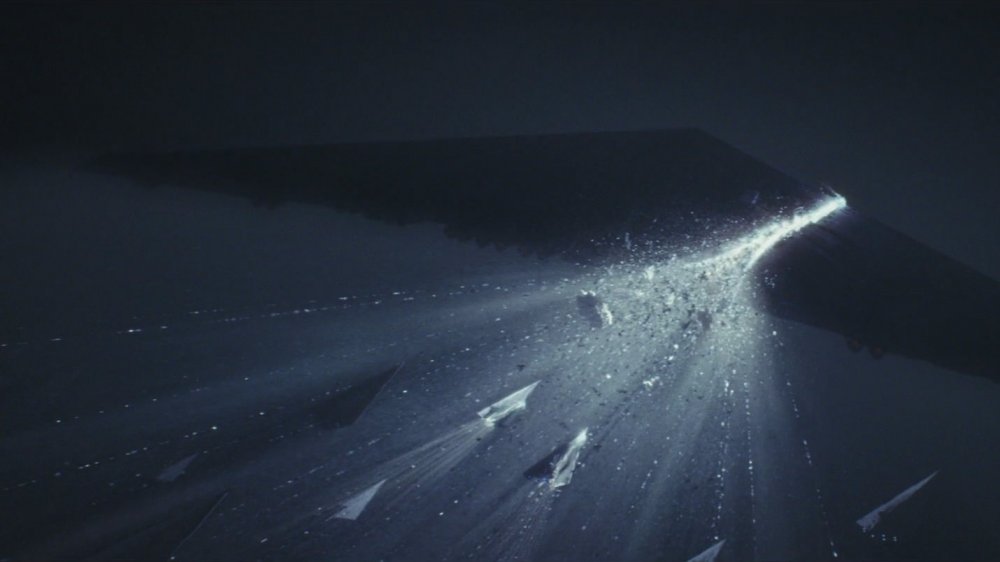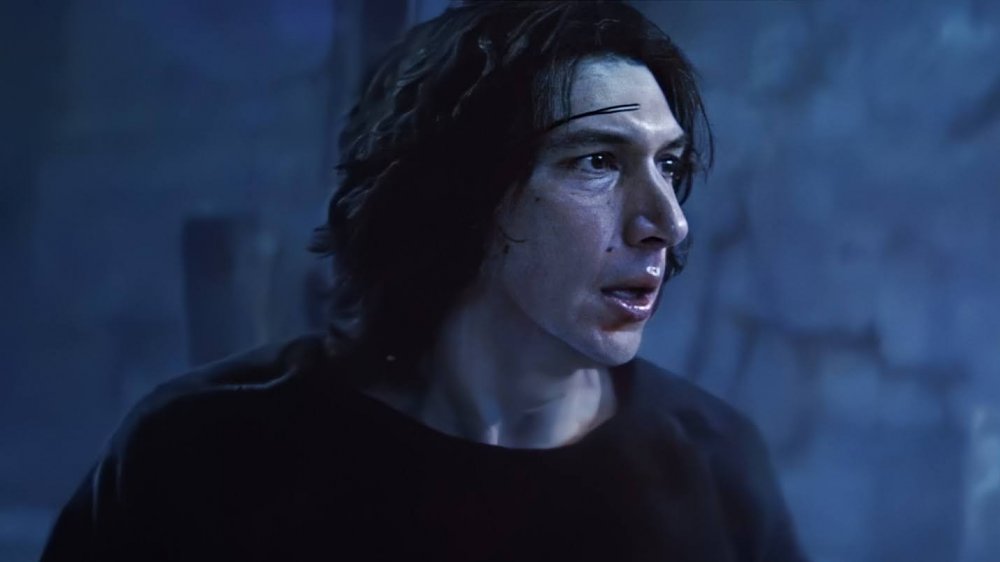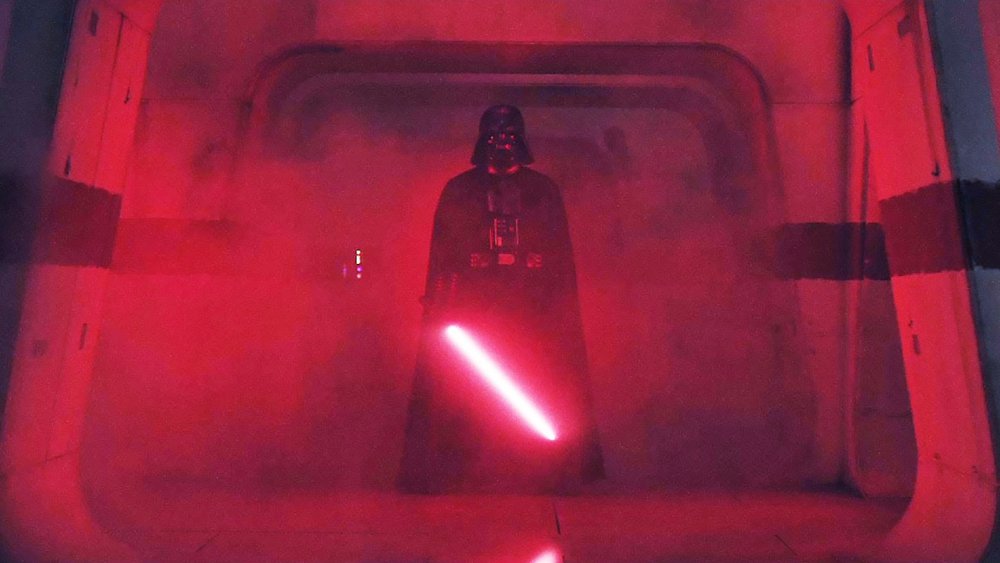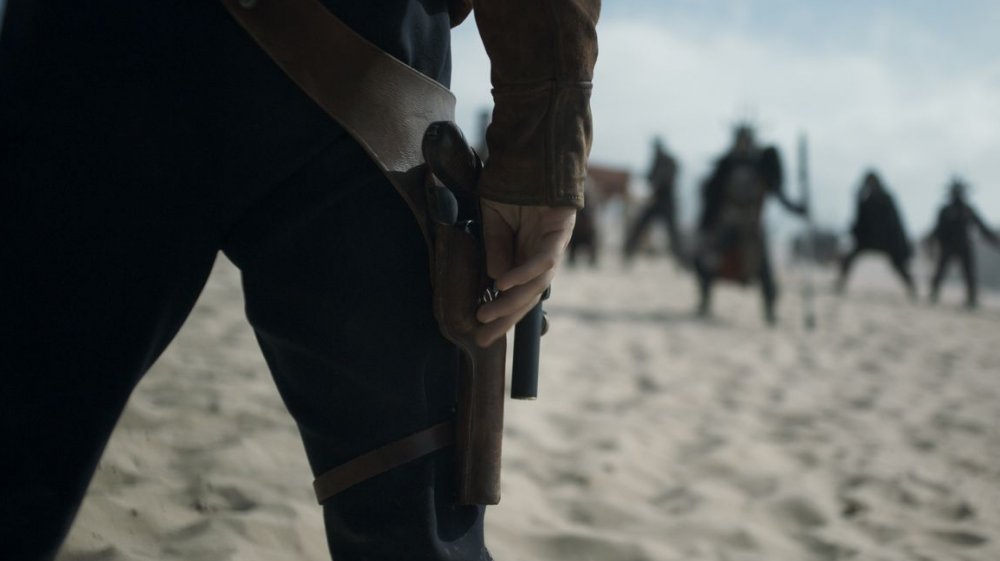The Most Iconic Scene From Every Star Wars Movie
There are few, if any, film franchises that have impacted the movie industry as much as Star Wars. When the first installment hit the screen in 1977, it blasted the culture with the force of a Star Destroyer dropping out of hyperspace, changing the way fans digest movies and the way studios produce them. Star Wars gave us a slew of the most repeated lines of dialogue in history, opened the doors for future juggernaut franchises like the MCU, and introduced us to Baby Yoda. What more can one film series do?
Over the course of 11 live-action films, we've watched the drama of the Skywalker Saga, the rise of a young Han Solo, and the early days of the Rebellion. And with each landmark movie, we've witnessed a whole host of memorable moments, from epic action scenes to emotional farewells. But which scenes are the ones that truly stick with us? Which ones really stand the test of time? Well, it's time to rely on our Jedi instincts, use the Force, and pick the most iconic scenes from every Star Wars movie.
(Be warned, there are spoilers below.)
The Phantom Menace: Now that's podracing
To say that there have been a few duds in the Star Wars canon would be an understatement. For example, take The Phantom Menace. The months leading up to its 1999 release were filled with excitement for fans. Then when the movie came out, it was largely met with confusion and disappointment. But that doesn't mean the movie didn't have its moments.
To give credit where credit is due, The Phantom Menace was an incredible case of worldbuilding, taking what we knew of the Star Wars universe and expanding it to a galactic scale. It showed how the foundations of the Galactic Republic began to crumble, brought a young Obi-Wan Kenobi to a nine-year-old Anakin Skywalker, and introduced the boy to the woman who would one day give birth to his children, Luke and Leia.
As a result, The Phantom Menace had a number of moments that stood out. There was the death of Qui-Gon Jinn and subsequent halving of Darth Maul by Obi-Wan, as well as when Yoda made the reluctant decision to allow Anakin to be trained in the Force. But in terms of a single scene that's truly unforgettable, it's hard to go with anything but Anakin's podrace. Visually and narratively thrilling, fun to watch every second of the way, it further introduced us to the lives of some truly bizarre creatures, and it expanded upon our concept of what it's really like in the Star Wars universe.
Attack of the Clones: Jedi melee
Attack of the Clones was widely maligned for its lackluster plot, one-dimensional characters, and abhorrent dialogue (tell us more about your feelings on sand, Anakin), but all that aside, it's impossible to deny that it had its fair share of exciting action.
As for the plot, Attack of the Clones jumps forward a decade after the events of its predecessor. The Republic has continued to spiral into chaos due to an expanding Separatist movement, and the Jedi — now with a young adult Anakin Skywalker among their ranks — are desperately trying to keep the peace. In the course of doing so, Obi-Wan discovers a massive clone army hidden on a distant planet, which provides the central thrust of the coming Clone Wars. His investigation takes him to the planet Geonosis, where he, Anakin, and Padme are captured and then sentenced to death by Separatist leader Count Dooku. Just as things are looking dire for the trio, Yoda, Mace Windu, seemingly the entire Jedi Order, and the clone army all swoop in and save the day.
And this scene is undeniably the most iconic of the movie. Never before had fans been treated to such a massive Jedi melee, and it's a dream come true. With all those lightsabers waving around wildly, it's no wonder Samuel L. Jackson asked George Lucas for Mace Windu to be given a distinctive purple blade, which allowed him to stand out in the crowd.
Revenge of the Sith: The downfall of Anakin Skywalker
After the undeniable disappointments of the first two installments in the prequel trilogy, Revenge of the Sith represented a major step forward in quality, bridging the gap between Attack of the Clones and A New Hope in a way that felt natural and seamless.
On top of its dark tone and its compelling story of Anakin falling into darkness, Revenge of the Sith is packed with iconic moments. For example, there's the scene where Palpatine, aka Darth Sidious, takes out three Jedi before lightning-blasting Mace Windu to his doom. Plus, you've got the sequence where Anakin massacres the younglings. Then there's the Yoda-Chewbacca team-up on Kashyyyk, Order 66 and the subsequent slaughter of the Jedi, Obi-Wan's epic lightsaber battle with General Grievous, and Yoda's duel with Palpatine. And, of course, there's the birth of Darth Vader. But since we have to pick just one, we're going with the defeat of Anakin at the hands of Obi-Wan.
While the fight itself probably ranks somewhere in the middle of all the saga's lightsaber duels, its import is practically unrivaled. Here we see the downfall of "the Chosen One" as a heartbroken Obi-Wan deals the tragic blow that leads Anakin directly into the famous black suit and mask. And knowing that the next time the two meet will be on the Death Star where Vader will kill his old master makes the emotion of the scene feel all the more earned.
A New Hope: Let's blow this thing
For most fans, A New Hope served as the first introduction to the Star Wars universe, telling us the story of how Luke Skywalker, Princess Leia, Han Solo, and their various sidekicks came together in the struggle against the Empire. And while many have argued that The Empire Strikes Back is technically a "better" film, it's impossible to deny the original installment is the greatest of the franchise.
It's exceedingly difficult to choose a single "most iconic" scene from one of the most iconic movies of all time. The argument could be made for the very first scene — the opening crawl with the eruption of John William's incredible score. You could also pick Luke staring out at the setting twin suns of Tatooine, and there's also the moment the three leads meet face to face while breaking Leia out of the Death Star.
When all is said and done, however, we have to give it to the trench run scene, in which Luke — aided by late-arrival Han Solo — fires the shot that destroys the Death Star. The ghostly voice of Obi-Wan urging Luke to "trust his feelings," a surprised Vader being spun into space by a shot from Solo, then finally Han's unforgettable line ("You're all clear, kid, now let's blow this thing and go home") followed by the big boom ... all of it adds up to one of the greatest scenes in movie history.
The Empire Strikes Back: Daddy issues
It's never an easy endeavor to make a sequel befitting of its predecessor, and after A New Hope, George Lucas and company had a Death Star-sized task ahead of them. But The Empire Strikes Back accomplished the impossible by delivering a sequel that not only progressed the story with all the engagement of the first, but it set the standard by which all sequels after it have been measured.
As with its forerunner, The Empire Strikes Back is packed with standout scenes. Need proof? Well, there's the speeders fighting against the Imperial Walkers, Han and Leia's first kiss, and Yoda's monologue about the power of the Force. Then we've got the asteroid field, Luke's failure in the cave, and Han and Leia's second kiss. But let's face it, no matter how great all of those moments are, perhaps the most iconic scene in the entire franchise comes when Vader reveals himself to be Luke's father.
It's the most pivotal moment in the original series, if not the entire saga, turning everything we thought we knew on its head and radically shifting Luke's intentions in the film to come. Few movie twists have ever been so unexpected and thrilling, and it's perhaps the most recognizable (if most misquoted) lines in movie history: "No, I am your father."
Return of the Jedi: Vader returns to the light
When many of us watched Return of the Jedi as kids, we didn't see it for the flawed movie it was. The entire first act of saving Han was fun but completely unconnected to the rest of the film. Boba Fett's death was bad to the point of being corny. Obi-Wan's "certain point of view" explanation now comes off as a weak attempt by Lucas to smooth out his lack of planning from one movie to the next. And the Ewoks ... oh, the Ewoks.
All that being said, it was a fun watch that capped off the original trilogy in a way that felt genuine and satisfying. The rescue of Han was awesome, and Yoda's send-off was suitably emotional. That final space battle was flat-out rad, and the Emperor turned out to be a worthy villain. Plus, "it's a trap" is meme gold.
But with Return of the Jedi, it's easy to pinpoint the standout scene. It comes near the end, when Vader tells Luke to remove his mask, revealing the smiling face of Anakin Skywalker. Having realized his connection to and affection for his son, Vader saved Luke from the Emperor's Force lightning at the last second, then cast Palpatine to his doom. (Or so we thought.) Vader's turn from the Dark Side and reemergence as Anakin is narratively perfect, emotionally satisfying, and brought the Skywalker story to a presumed close that maybe should've been left as it was.
The Force Awakens: So long, Solo
The third Star Wars trilogy kicked off with The Force Awakens, which introduced us to a new generation of leads. In a nutshell, the movie revolves around the rise of a novel iteration of the Empire known as the First Order and its first major attack on the New Republic with the use of a massive Death Star-like weapon called Starkiller Base, all while Leia and company search for the long-missing Luke Skywalker. Along the way, we're introduced to the Force-sensitive orphan Rey, cocky Resistance pilot Poe, reformed stormtrooper Finn, and the new Darth Vader stand-in, Kylo Ren — the son of Leia and Han Solo who turned to the Dark Side after Luke's failure at training him.
Without a doubt, the most memorable occurrence in the film comes near the climax when Han Solo, Rey, Finn, and Chewie have gone to Starkiller Base to lower its shields, thereby clearing the way for a Resistance air assault. While there, Solo crosses paths with his son, and they have an emotional exchange about the young Ren's plunge into the Dark Side. Seeming to consider his father's plea for him to return to the Light, Ren suddenly ignites his lightsaber, piercing and killing Han.
It was a shocking turn of events that had audience members gasping and even crying in horror, and it was undeniably one of the most iconic moments in the entire franchise.
Last Jedi: The Holdo Maneuver
One of the most divisive installments in the franchise, The Last Jedi finds our heroes in a tough spot. Following a disastrous battle against the First Order, the Resistance fighters are contained on a single command ship. Pursued by enemies and running out of fuel, Resistance leaders realize that the First Order has the ability to track ships through hyperspace, and thus, no easy way out presents itself. To make matters worse, Leia is nearly killed in an assault on the ship, which puts her in a coma and places command in the hands of a somewhat mysterious Admiral Holdo. As time runs out, the Resistance desperately searches for a means of escape.
Finally, having devised a plan to sneak their personnel off the ship using small transports, the Resistance abandons the carrier, leaving Holdo aboard to pilot it until the last moment. Only then do the good guys realize that the First Order has seen through their plan, when the villains begins firing upon the escape transports.
It's here that we get one of the most visually stunning scenes in the entire series. In a last-ditch attempt to save the Resistance, Holdo directs the ship at the First Order fleet, then punches it into hyperspace, splitting the lead Destroyer in two and sending out shock waves of debris that devastate the enemy. An exciting moment that looks incredible, this kamikaze move will remain one of the franchise's most memorable moments.
The Rise of Skywalker: Good Ben
The Rise of Skywalker beat out The Phantom Menace for the dubious distinction of having the lowest Rotten Tomatoes score in the entire franchise. But while the movie undeniably had its share of problems, that doesn't mean that it was without its standout moments.
The film opens with the reveal that Emperor Palpatine is still alive and plotting his revenge. After locating the wayward Sith Lord, Kylo Ren learns that Palpatine has been directing him all along, using Snoke as a puppet to turn Kylo to the Dark Side while controlling the First Order. At the same time, Rey, Poe, and Finn undergo a series of misadventures over the course of their search for the Emperor, and in doing so, they cross paths with Kylo, who informs Rey that she is, in fact, Palpatine's granddaughter.
Shortly after this, Kylo encounters a vision of his father, Han Solo, who successfully inspires his son to cast off his lightsaber and turn to the Light Side of the Force, reclaiming his identity as Ben Solo. Ben and Rey then join forces to destroy the Emperor while the Resistance defeats his massive fleet of Star Destroyers.
While the return of Palpatine is certainly a big deal, we've got to give the nod for "most iconic" to the return of Ben Solo. His rejection of evil in favor of the Light Side not only perfectly mirrors his grandfather Anakin's actions at the close of the previous trilogy, but it helps to bolster the somewhat muddled prophecy that the Skywalker line would help bring balance to the Force.
Rogue One: Darth Vader comes out swinging
A prequel film set before A New Hope, Rogue One follows a young criminal and rebel named Jyn Erso, whose father was the scientist largely responsible for designing the Death Star. When Jyn is freed from an Imperial labor camp by an agent of the Rebel Alliance, she embarks on a mission to help find and rescue her father from the Empire in the hopes that he'll be able to help them defeat the weapon. When they do find him, he reveals that he's built a devastating weakness into the Death Star, and that the Rebels can take advantage of it if they can acquire the plans for the planet-killing base on the planet of Scarif. Jyn accompanies a strike team to the planet where they successfully transmit the plans to the Alliance, but then, our heroes are killed by a shot from the Death Star.
While the movie has its fair share of high points, none compare to Rogue One's final scene that bridges the gap between the movie and the first moments of A New Hope. A team of Imperial attackers break into the Rebel cruiser carrying the Death Star plans, with the fearsome Darth Vader at their lead. As he hacks his way through the Rebel defenders, we're treated to what's arguably the most frenzied Vader assault put to screen. The Rebels barely escape the Sith Lord, carrying the disk containing the plans onto a familiar cruiser, which quickly races away. We end the movie on a young Princess Leia, who we know, having seen A New Hope, will be captured in short order by Vader and his Star Destroyer.
Solo: Han shoots first
Solo: A Star Wars Story opens with a young Han Solo living as a thief on his home planet of Corellia. After escaping his dismal circumstances by joining the Imperial Flight Academy, he finds himself booted out for insubordination and serving as an infantryman. Next, he's arrested due to a false accusation of desertion, and he's soon locked up with his future copilot, Chewbacca. The two make their escape and join a gang of thieves intent on making a big heist of the valuable fuel coaxium. The plan goes awry, and most of the pirates are killed, placing Han at odds with the leader of the gang. When the two face off in an Old West-style duel, Han shoots the other smuggler without waiting for the latter to draw his weapon.
This final shoot-out is not only the most iconic moment in the movie, but it speaks to a key debate that's raged within the Star Wars fan community for decades. When George Lucas updated the original trilogy in 1997, he notoriously edited A New Hope to make it appear that the bounty hunter Greedo shot at Han before the smuggler pulled his blaster. As a result, whether or not "Han shot first" has been hotly contested ever since. With Solo, the filmmakers are saying that shooting first to protect one's own skin is a lesson that Han learned at an early age, thereby laying the debate to rest.
